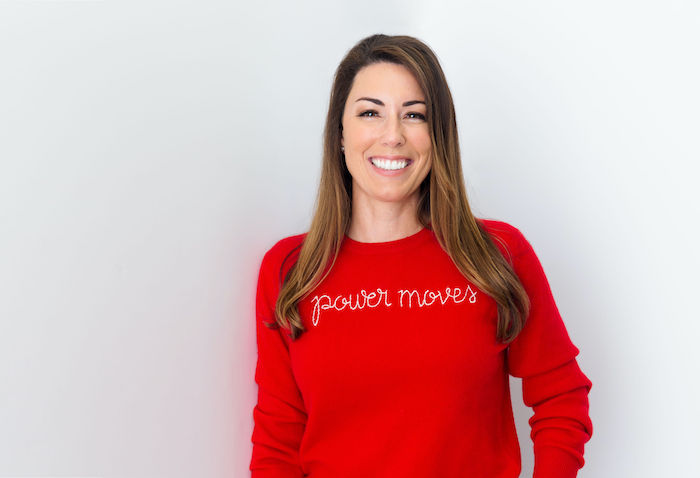The Persistent Career Myth That’s Making You More Unhappy In Your Actual Job

The following is an excerpt from Power Moves: How Women Can Pivot, Reboot, and Build a Career Of Purpose by Lauren McGoodwin, whom you may recognize as Career Contessa. Power Moves will hit shelves 5/19, but if you pre-order now, you’ll get a bunch of extras. (Lauren will also be answering your career questions on our Instagram today, so make sure to tune in here!)
When you imagine your dream job, it’s probably a tad fuzzy, more like the “concept” of work than actually working. In this land of professional make-believe, you’ve identified a career you are passionate about and landed a position that is a consistent source of happiness and fulfillment, where you get to live a balanced life while being valued, respected, rewarded, and more than well compensated for what you do. Sounds idyllic, right? I know how lovely that daydream is because I lived inside it for a long time, and why this concept matters so much is because you can spend a lot of time, energy, and mental space landing that dream job, only to discover something is still missing. Life is not a Monopoly game. There is no passing “go” and collecting two hundred dollars. If you pass “go” in real life and ditch the work required to build a career on your terms, you end up in an ambition ditch.
In a study from 2017, researchers at Stanford University found the myth of the dream job is closely aligned with the myth that human beings have “fixed” passions and that once we “find our passion” and apply it to work, we will be fulfilled. This philosophy suggests that, at a certain point, we stop developing areas of interest and that we won’t need to expand and grow. It can be stifling and limiting to signify an endgame when many of us have just gotten started, and, perhaps worst of all, it can make us tired and reluctant to try new things. According to the Stanford study: “Urging people to find their passion may lead them to put all their eggs in one basket but then to drop that basket when it becomes difficult to carry.”
So, spoiler alert: turns out the dream job is a gargantuan, intangible concept because . . . it doesn’t really exist, nor would you want it to. While it may be tidy to think so, our dreams are never about just one destination—the best careers are circuitous, meandering, and a little bit wild.
They adapt to our changing work-life needs and keep us excited and engaged. The perfect job when you’re in your twenties will most likely be totally different to you when you’re in your thirties, forties, and beyond, which is a great thing!
To quote a woman I’ve long admired, Ellevest CEO Sallie Kraw- check from a February 2018 interview for Quartz at Work: “I wish I had known that that process of figuring out what you’re good at, what you want to do, and where you want to have an impact is not a one-time exercise, but an ongoing one. Instead, I bought into success being an endpoint rather than a constant process. Your career is not going to go the way you planned. It is impossible at the age of 23 to pick the right industry, the right company, and you can visualize what you’re going to be doing in your 40s, 50s, and 60s, but chances are that it’s going to be something quite different. So, remain open to opportunities and change.”
The best thing you can do to keep yourself unstuck is to ditch the dream job altogether.
“Our dreams are never about just one destination—the best careers are circuitous, meandering, and a little bit wild”
What You Should be Doing Instead
All of this doesn’t mean you can’t find (or create) a job you love. Finding a job you love starts with you—and understanding what you really want and need. And by the way, understanding what you really want and need is not always what you first think.
To get started, we’re going to make some lists. For many of us, the task of being asked to write lists is like asking a sugar addict trying to avoid cravings to attend the Museum of Ice Cream. We know you love making lists, but these are going to be different because they are far from your daily to-do list. And we need you to promise that you won’t jump into the pool of sprinkles (ahem, to-do lists) and that’s the last we ever hear from you. We need you to stay focused on these lists because they will build toward a major Power Move. And remember that these lists are based on how you feel right now—as your career interest and stage in life evolve, you can make new lists.
Creating some preliminary lists will help you turn this dream job paradigm on its tired head. These lists are the start of letting go of the idea of a “dream job” and allowing yourself to identify and seek work you need that fits into the life you want. We call these your career ideals. Let’s break this down into some actionable lists, starting with identifying your career ideals or, in more simple terms, your wants and needs.
Identify What You Want
Desire is tricky, of course, as it tends to be myopic, materialist, and often unrealistic. “I want a brownstone in Brooklyn!” “I would like to vacation internationally each month and wear new designer clothes while I’m doing it!” “How about a summer home?!” “Ready for my in-home chef to arrive any day now!” When you’re listing out what you “want,” start small, try to stay away from the material for now, and zero in on the “nice-to-haves” that would elevate your day-to-day life and help you feel more content and satisfied.
Identify Your Needs
Your needs differ from wants because they are non-negotiable, fixed, your “must-haves.” Are you a parent? A caretaker? The breadwinner of your family? Do you have special needs that your work must fulfill?
Organize Your Career Ideals
Let’s organize your career ideals and prioritize each. For example, if you identified that you want to work with a team, you can get more specific by describing that you “need to have” at least one colleague but a “nice-to-have” would be a team of four or five. Maybe your “want” item is a team that works in-person together. By thinking through your wants and needs more, you’ll better understand what’s really important to you. As well, recognize that your career ideals will change throughout your life, so you can revisit this worksheet at any time.
Identify Your Target Companies
Now comes a fun part. You get to go on a scavenger hunt of sorts. Take your list of career ideals and shelve them for a bit while we explore companies where you might like to work—we’ll call these target companies. For now, your list of companies should be broad—don’t limit yourself. Your list might include websites you read often, products you love, industries you’re obsessed with, services you’re a longtime fan of, or even the company where your BFF works. Perhaps you’re interested in companies that offer specific perks, ones you follow in the news or really admire because of their leadership team.
The goal is to create a long list of companies and be able to answer why each made the list with at least one sentence. And get creative by browsing additional sites like InHerSight, Glassdoor, Indeed, LinkedIn, Built In, and The Muse, while taking note of any companies you might want to learn more about. Add those to your Target Companies list.
Get to Know Your Target Companies
By now, you know what’s important to have in your career. And you’ve also identified target companies. Now comes the part where we start to match companies to your career ideals, and this is where the (career) magic happens. We like to compare this to ordering a massive amount of clothes online, and now you’ll be trying on each item/company to see if it fits. Only the target companies that match a majority of your career ideals should remain on your list. You might have to reprioritize your career ideals even more as you compare them to your target companies.
You can determine which companies stay—and which ones go—by using the Company Research worksheet for each company on your Target Companies list. You’ll get to know the organizations much more extensively—and in way more detail than what you learn from a single job description. From there, you can cross off any target companies that are misaligned with your career ideals, which you might also adjust in this process.
Let’s use an example to see how this works. You know your lifestyle isn’t compatible with a lengthy commute. Given your additional research, you conclude that the hypothetical Acme Company requires a commute of at least thirty minutes each way, which of course is not suited to your needs unless they offer flexible work hours (which they don’t). So, Acme Company ends up getting removed from your list of target companies.
Last, you can narrow down your list of target companies even further by asking yourself the following questions:
- Would working at this company require me to move/would I be willing to move?
- How does my experience align with the work this company does?
- What kind of work would I like to do for them?
- What experience or additional training do I need for this kind of role?
- Is there anyone in my network who can connect me to this company?
- Is there anyone with whom I could conduct an informational interview?
For companies that are aligned with you, it’s time to start considering departments or roles that might be a good fit and focus your job search on just these specific companies. The more focused and specific your job search is, the more success you’ll have with it. In recruiting we have a phrase called “spray and pray.” This is when a candidate sprays their résumé all over the internet and prays that a recruiter will pick it up. They won’t. Recruiters and companies are looking for candidates who can not only add value to the organization, solve challenges, collaborate with others, etc., but also clearly make a case for how their values and goals align with those of a target company. Value fitting is how you find a job you love, a genuine culture and role match that your ideal company clearly wants.
The following was an excerpt from Power Moves: How Women Can Pivot, Reboot, and Build a Career Of Purpose by Lauren McGoodwin.
POWER MOVES. Copyright © 2020 by Lauren McGoodwin. Reprinted here with permission from HarperBusiness, an imprint of HarperCollins Publishers.
Like this story? Follow The Financial Diet on Facebook, Instagram, and Twitter for daily tips and inspiration, and sign up for our email newsletter here.




